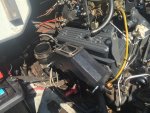No bubbles. That was the first thing I tested, definitely no air leaks, neither stationary nor on the plain.
I did not back-flush the raw water pickup line yet. Could not figure out how to do it. I'd need an adapter from a garden hose (the only thing I have with some pressure in it) to 1-1/4" barb, which I don't have. Even then, the garden hose is much smaller, I am not sure it can create strong enough back flow. Besides, with vacuum reading being low (not enough vacuum in the pickup line) I thought the pickup line blockage is unlikely. In any case, I am ordering a 1-1/4 ID reinforced hose with a 1-1/4x1' barb adapter to bypass the pickup line from the oil cooler to the pump. We'll see...
I am contemplating another test. I want to hook up a garden hose to each manifold and measure the flow rate. Any idea what kind of flow I should be seeing?
I do not think this is a pump problem. The riser overheating problem was there with the old pump as well. (the old pump developed a leak, leading to its replacement, but was running fine with a new impeller)
I did not back-flush the raw water pickup line yet. Could not figure out how to do it. I'd need an adapter from a garden hose (the only thing I have with some pressure in it) to 1-1/4" barb, which I don't have. Even then, the garden hose is much smaller, I am not sure it can create strong enough back flow. Besides, with vacuum reading being low (not enough vacuum in the pickup line) I thought the pickup line blockage is unlikely. In any case, I am ordering a 1-1/4 ID reinforced hose with a 1-1/4x1' barb adapter to bypass the pickup line from the oil cooler to the pump. We'll see...
I am contemplating another test. I want to hook up a garden hose to each manifold and measure the flow rate. Any idea what kind of flow I should be seeing?
I do not think this is a pump problem. The riser overheating problem was there with the old pump as well. (the old pump developed a leak, leading to its replacement, but was running fine with a new impeller)






















